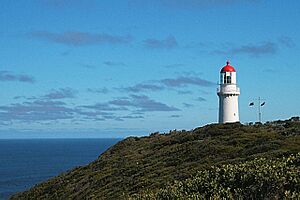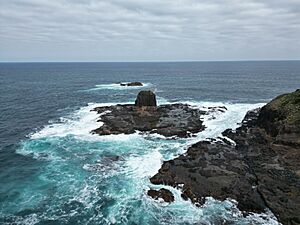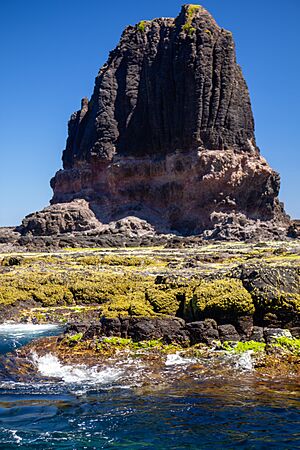Cape Schanck facts for kids
Quick facts for kids Cape SchanckVictoria |
|||||||||
|---|---|---|---|---|---|---|---|---|---|

Cape Schanck looking towards Pulpit Rock at dawn
|
|||||||||
| Population | 569 (2021 census) | ||||||||
| Postcode(s) | 3939 | ||||||||
| Elevation | 79 m (259 ft) | ||||||||
| Location |
|
||||||||
| LGA(s) | Shire of Mornington Peninsula | ||||||||
| State electorate(s) | Nepean | ||||||||
| Federal Division(s) | Flinders | ||||||||
|
|||||||||
Cape Schanck is a beautiful area located at the very end of the Mornington Peninsula in Victoria, Australia. It's about 72 kilometers south of Melbourne, which is the capital city. This special place is known by its traditional Boonwurrung name, Tunnahan.
Cape Schanck is where the wild Bass Strait ocean meets the slightly calmer waters of Western Port. One of its most famous sights is the Cape Schanck Lighthouse. This lighthouse was built way back in 1859 and was only the second one ever built in Victoria! Another cool landmark is Pulpit Rock, a unique rock formation right at the tip of the cape.
The area is also home to the RACV Resort Cape Schanck. This resort has a big golf course with eighteen holes. There's also The National Golf Club nearby.
Many years ago, a British-Australian artist named Georgiana McCrae painted many of her artworks right here at Cape Schanck. Another artist, Nicholas Chevalier, loved to capture the amazing natural beauty and dramatic skies of Cape Schanck in his paintings.
Contents
Discovering Cape Schanck's Past
What's in a Name?
The original name for this cape, given by the Boonwurrung people, is Tunnahan.
The European name, Cape Schanck, was given in 1800. It was named after Captain John Schank, a naval officer, by Lieutenant James Grant. Grant was sailing on a ship called the Lady Nelson. Interestingly, Captain Schank had designed a special part of the Lady Nelson ship. The spelling of 'Schanck' with two 'c's is actually a mistake!
Another explorer, Nicolas Baudin, sailed past in 1802 and called it Cap Richelieu.
Post Office and Shipwrecks
A Post Office opened in Cape Schanck around 1879 but closed many years later in 1962.
In 1893, a steamship called the SS Alert sank off the coast of Cape Schanck during a big storm. After 113 years, the ship was found again on the ocean floor in June 2007.
Amazing Animals and Plants
Cape Schanck is a great place to spot different kinds of birds. You might see large albatrosses flying near the cliffs, like the black-browed albatross or Indian yellow-nosed albatross. During spring, many short-tailed shearwaters fly past as they migrate.
Other birds you might spot include black-faced and pied cormorants, kelp gulls, and Australasian gannets. Smaller birds like brown thornbills and singing honeyeaters often live in the shrubs. Sometimes, the hard-to-find striated fieldwren can also be seen here.
Some of the plants you'll find growing in the area include cushion bushes.
Images for kids








